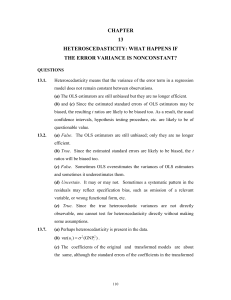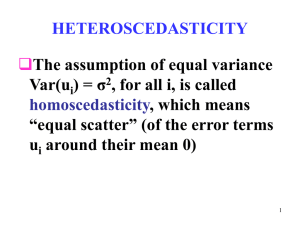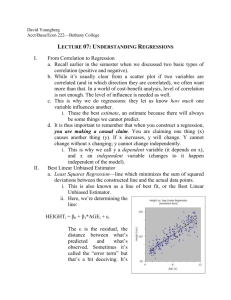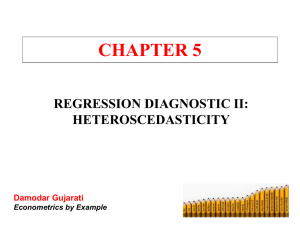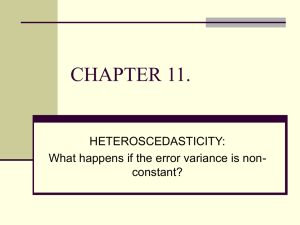SSSII Lecture 6: Heteroscedasticity
advertisement
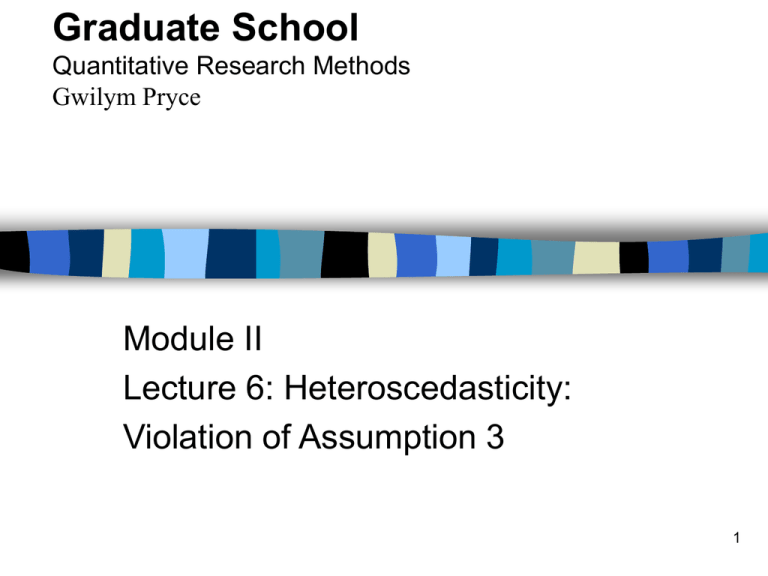
Graduate School Quantitative Research Methods Gwilym Pryce Module II Lecture 6: Heteroscedasticity: Violation of Assumption 3 1 Plan: 1. What is heteroscedasticity? 2. Causes 3. Consequences 4. Detection 5. Solutions 2 1. What is heteroscedasticity? Recall that for estimation of coefficients and for regression inference to be correct: – – – – – – 1. Equation is correctly specified: 2. Error Term has zero mean 3. Error Term has constant variance 4. Error Term is not autocorrelated 5. Explanatory variables are fixed 6. No linear relationship between RHS variables When assumption 3 holds, – i.e. the errors ui in the regression equation have common variance (ie constant or scalar variance) then we have homoscedasticity. – or a “scalar error covariance matrix” When assumption 3 breaks down, we have what is known as heteroscedasticity. – or a “non-scalar error covariance matrix” (also caused by 4.)3 Recall that the value of the Residual for each observation i is the vertical distance between the observed value of the dependent variable and the predicted value of the dependent variable – I.e. the difference between the observed value of the dependent variable and the line of best fit value: 4 Case 1 2 3 4 5 6 7 8 9 10 Price Predicted Price 19000 19174.0 30000 28028.7 8100 45738.2 55000 36883.5 130000 45738.2 55000 45738.2 54000 36883.5 7500 45738.2 36000 36883.5 32000 28028.7 Residual -174.0 1971.3 -37638.2 18116.5 84261.8 9261.8 17116.5 -38238.2 -883.5 3971.3 N.B. Predicted price is the value on the regression line that corresponds to the values of the dependent variables (in this case, No. rooms) for a particular observation. 5 (Assume that this represents multiple observations of y for each given value of x): 400000 300000 200000 +ive residual 100000 -ive residual + - 0 -100000 0 2 4 Number of rooms 6 8 10 12 14 6 Homoskedasticity => variance of error term constant for each observation cov( u1 , u2 ) cov( u1 , un ) var( u1 ) cov( u , u ) var( u ) cov( u , u ) 2 1 2 2 n cov( u1 , u2 ,....un ) var( un ) cov( un , u1 ) cov( un , u2 ) 2 0 0 2 0 0 wher e 2is a scalar 2 0 0 7 Each one of the residuals has a sampling distribution, each of which should have the same variance -- “homoscedasticity” Clearly, this is not the case within in this sample, and so is unlikely to be true across samples: 8 400000 300000 200000 +ive residual 100000 -ive residual + - 0 -100000 0 2 4 Number of rooms 6 8 10 12 14 9 This is confirmed when we look at the standard deviation of the residual for different parts of the sample S t E e N e i N a U > 9 6 0 7 < 6 1 1 3 S t E e N e i N a U > 2 8 5 5 < 3 3 3 5 10 2. Causes What might cause the variance of the residuals to change over the course of the sample? – the error term may be correlated with: • either the dependent variable and/or the explanatory variables in the model, • or some combination (linear or non-linear) of all variables in the model • or those that should be in the model. – But why? 11 (i) Non-constant coefficient Suppose that the slope coefficient varies across i: yi = a + bi xi + ui suppose that it varies randomly around some fixed value b: bi = b + ei then the regression actually estimated by SPSS will be: yi = a + (b + ei) xi + ui = a + b xi + (ei xi + ui) where (ei x + ui) is the error term in the SPSS regression. The error term will thus vary with x. 12 (ii) Omitted variables Suppose the “true” model of y is: yi = a + b1xi + b2zi + ui but the model we estimate fails to include z: yi = a + b1xi + vi then the error term in the model estimated by SPSS (vi) will be capturing the effect of the omitted variable, and so it will be correlated with z: vi = c zi + ui and so the variance of vi will be non-scalar 13 (iii) Non-linearities If the true relationship is non-linear: yi = a + b xi2 + ui but the regression we attempt to estimate is linear: yi = a + b xi + v i then the residual in this estimated regression will capture the non-linearity and its variance will be affected accordingly: vi = f(xi2, ui) 14 (iv) Aggregation Sometimes we aggregate our data across groups: – e.g. quarterly time series data on income = average income of a group of households in a given quarter if this is so, and the size of groups used to calculate the averages varies, variation of the mean will vary • larger groups will have a smaller standard error of the mean. the measurement errors of each value of our variable will be correlated with the sample size of the groups used. Since measurement errors will be captured by the regression residual regression residual will vary the sample size of the underlying groups on which the data is based. 15 3. Consequences Heteroscedasticity by itself does not cause OLS estimators to be biased or inconsistent* – NB neither bias nor consistency are determined by the covariance matrix of the error term. However, if heteroscedasticity is a symptom of omitted variables, measurement errors, or non-constant parameters, OLS estimators will be biased and inconsistent. 16 Unbiased and Consistent Estimator b̂ Asymptotic Distribution of OLS Estimate b hat The Estimate is Unbiased and Consistent since as the sample size increases, the mean of the distribution tends towards the population value of the slope coefficient b 4.5 n = 1,000 4 3.5 n = 500 3 n = 300 2.5 2 n = 200 1.5 n = 150 1 0.5 b 7.9 7.55 7.2 6.85 6.5 6.15 5.8 5.45 5.1 4.75 4.4 4.05 3.7 3.35 3 2.65 2.3 1.95 1.6 1.25 0.9 0.55 0.2 -0.2 -0.5 -0.9 -1.2 -1.6 -1.9 -2.3 -2.6 -3 -3.3 -3.7 -4 0 b hat 17 Biased but Consistent Estimator b̂ Asymptotic Distribution of OLS Estimate b hat The Estimate is Biased but Consistent since as the sample size increases, the mean of the distribution tends towards the population value of the slope coefficient b 4.5 n = 1,000 4 3.5 n = 500 3 n = 300 2.5 2 n = 200 1.5 n = 150 1 0.5 b 7.9 7.55 7.2 6.85 6.5 6.15 5.8 5.45 5.1 4.75 4.4 4.05 3.7 3.35 3 2.65 2.3 1.95 1.6 1.25 0.9 0.55 0.2 -0.2 -0.5 -0.9 -1.2 -1.6 -1.9 -2.3 -2.6 -3 -3.3 -3.7 -4 0 b hat 18 – NB not heteroskedasticity that causes the bias, – but failure of one of the other assumptions that happens to have hetero as the side effect. testing for hetero. is closely related to tests for misspecification generally. • Unfortunately, there is usually no straightforward way to identify the cause – Heteroskedasticity does, however, bias the OLS estimated standard errors for the estimated coefficients: • which means that the t tests will not be reliable: t = bhat /SE(bhat). – F-tests are also no longer reliable • e.g. Chow’s second Test no longer reliable (Thursby) 19 4. Detection Q/ How can we tell whether our model suffers from heteroscedasticity? 20 4.1 Specific Tests/Methods (A) Visual Examination of Residuals – See above (B) Levene’s Test – See last term (C) Goldfeld-Quandt Test: • S.M. Goldfeld and R.E. Quandt, "Some Tests for Homoscedasticity," Journal of the American Statistical Society, Vol.60, 1965. H0: i2 is not correlated with a variable z H1: i2 is correlated with a variable z 21 G-Q test procedure is as follows: – (i) order the observations in ascending order of x. – (ii) omit p central observations (as a rough guide take p n/3 where n is the total sample size). • This enables us to easily identify the differences in variances. – (iii) Fit the separate regression to both sets of observations. • The number of observations in each sample would be (n - p)/2, so we need (n - p)/2 > k where k is the number of explanatory variables. – (iv) Calculate the test statistic G where: G = RSS2/ (1/2(n - p) -k) RSS1/ (1/2(n - p) -k) G has an F distribution: G ~ F[1/2(n - p) - k, 1/2(n - p) -k] • NB G must be > 1. If not, invert it. Prob: In practice we don’t usually know what z is. – But if there are various possible z’s then it may not matter which one you choose if they are all highly correlated which each other. 22 4.2 General Tests A. Breusch-Pagan Test : • T.S. Breusch and A.R. Pagan, "A Simple Test for Heteroscedasticity and Random Coefficient Variation," Econometrica, Vol. 47, 1979. – Assumes that: i2 = a1 + a2z1 + a3 z3 + a4z4 … am zm [1] where z’s are all independent variables. z’s can be some or all of the original regressors or some other variables or some transformation of the original regressors which you think cause the heteroscedasticity: e.g. i2 = a1 + a2exp(x1) + a3 x32 + a4x4 23 Procedure for B-P test: (i) Obtain OLS residuals uihat from the original regression equation and construct a new variable g: gi = uhat 2 / ihat 2 where ihat 2 = RSS / n (ii) Regress gi on the z’s (include a constant in the regression) (iii) B = 1/2(REGSS) from the regression of gi on the z’s, where B has a Chi-square distribution with m-1 degrees of freedom. 24 Problems with B-P test: B-P test is not reliable if the errors are not normally distributed and if the sample size is small Koenker (1981) offers an alternative calculation of the statistic which is less sensitive to non-normality in small samples: BKoenker = nR2 ~ c2m-1 where n and R2 are from the regression of uhat 2 on the z’s, where BKoenker has a Chi-square distribution with m-1 degrees of freedom. 25 B. White (1980) Test – The most general test of heteroscedasticity • no specification of the form of hetero required – (i) run an OLS regression - use the OLS regression to calculate uhat 2 (i.e. square of residual). – (ii) use uhat 2 as the dependent variable in another regression, in which the regressors are: • (a) all "k" original independent variables, and • (b) the square of each independent variable, (excluding dummy variables), and all 2-way interactions (or crossproducts) between the independent variables. – The square of a dummy variable is excluded because it will be perfectly correlated with the dummy variable. • Call the total number of regressors (not including the constant term) in this second equation, P. 26 – (iii) From results of equation 2, calculate the test statistic nR2 ~ c2 P where n = sample size, and R2 = unadjusted coefficient of determination. • The statistic is asymptotically (I.e. in large samples) distributed as chi-squared with P degrees of freedom, where P is the number of regressors in the regression, not including the constant 27 Notes on White’s test: The White test does not make any assumptions about the particular form of heteroskedasticity, and so is quite general in application. – It does not require that the error terms be normally distributed. – However, rejecting the null may be an indication of model specification error, as well as or instead of heteroskedasticity. generality is both a virtue and a shortcoming. – It might reveal heteroscedasticity, but it might also simply be rejected as a result of missing variables. – it is "nonconstructive" in the sense that its rejection does not provide any clear indication of how to proceed. NB: if you use White’s standard errors, eradicating the heteroscedasticity is less important. 28 Problems: Note that although t-tests become reliable when you use White’s standard errors, Ftests are still not reliable (so Chow’s first test still not reliable). White’s SEs have been found to be unreliable in small samples – but revised methods for small samples have been developed to allow robust SEs to be calculated for small n. 29 5. Solutions A. Weighted Least Squares B. Maximum likelihood estimation. (not covered) C. White’s Standard Errors 30 A. Weighted Least Squares – If the differences in variability of the error term can be predicted from another variable within the model, the Weight Estimation procedure (available in SPSS) can be used. • computes the coefficients of a linear regression model using WLS, such that the more precise observations (that is, those with less variability) are given greater weight in determining the regression coefficients. – Problems: • Wrong choice of weights can produce biased estimates of the standard errors. – we can never know for sure whether we have chosen the correct weights, this is a real problem. • If the weights are correlated with the disturbance term, then the WLS slope estimates will be inconsistent. • Also: Dickens (1990) found that errors in grouped data may be correlated within groups so that weighting by the square root of the group size may be inappropriate. See Binkley (1992) for an assessment of tests of grouped heteroscedasticity. 31 C. Whites Standard Errors – White (op cit) developed an algorithm for correcting the standard errors in OLS when heteroscedasticity is present. – The correction procedure does not assume any particular form of heteroscedasticity and so in some ways White has “solved” the heteroscedasticity problem. 32 Summary (1) Causes (2) Consequences (3) Detection (4) Solutions 33 Reading: Kennedy (1998) “A Guide to Econometrics”, Chapters 5,6,7 & 9 Maddala, G.S. (1992) “Introduction to Econometrics” chapter 12 Field, A. (2000) chapter 4, particularly pages 141-162. Green, W. H. (1990) Econometric Analysis Grouped Heteroscedasticity: – Binkley, J.K. (1992) “Finite Sample Behaviour of Tests for Grouped Heteroskedasticity”, Review of Economics and Statistics, 74, 563-8. – Dickens, W.T. (1990) “Error components in grouped data: is it ever worth weighting?”, Review of Economics and Statistics, 72, 328-33. Breusch Pagan critique: – Koenker, R. (1981) “A Note on Studentizing a Test for Heteroskedascity”, Journal of Applied Econometrics, 3, 13943. 34
